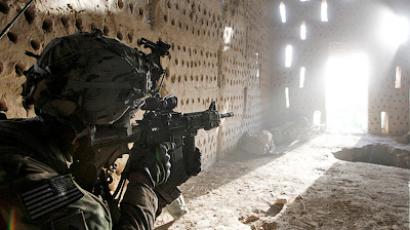NATO's business strategy: No need to attack, just buy them up (Op-Ed)

On August 1, the first NATO military facility in Russia is launching its operations. The site, designed to assist NATO's withdrawal from Afghanistan, is the latest component in the alliance's strategy of tightening its grip on Central Asia.
While the first military supplies to Afghanistan began traversing Russia in 2009, opening the “Transatlantic” alliance’s first military facility in the middle of the Eurasian continent, on the Volga river, is a tremendous achievement for NATO – and an even bigger defeat for Russia. The Ulyanovsk facility represents a new stage for the US in building a military, political, social, and economic fabric of support inside Russia. It brings into Russia itself the military network that the US and NATO have set up in Central Asian states. In this region, Washington's approach differs from the one used in Libya and Syria: instead of conquering with tanks and fighter jets, the US and NATO are now buying their way into target countries, and it proves to be a much more efficient method of conquest. NATO has offered economic arguments: it’s business for your companies, revenues for your budget, jobs for your people.There are two major projects that affect US and NATO penetration into the Eurasian heartland: the Northern Distribution Network (NDN) and the Modern Silk Road (MSR).The Northern Distribution Network – NATO’s Ulyanovsk “transit center” being a part of it – is a military supply route connecting venomously anti-Russian NATO member Latvia and aspirant Georgia with Afghanistan via Russia, Central Asia, and the Caucasus region. Designed by the US Transportation Command, US Central Command, the Defense Logistics Agency, and the Center for Strategic and International Studies (CSIS) in Washington DC, NDN, according to the authors, serves the military’s immediate needs, but also offers “a unique opportunity for Washington to further longer-term strategic goals.” This “series of commercially-based logistical arrangements” will “increase in America’s presence,” help the United States “further its interests within transit states” and is “paired with renewed, long-term US engagement.”The Modern Silk Road, as conceived by the same strategists, is a giant network of diverse communication lines, from transportation to electricity to telecommunications to pipelines that would run “from Hamburg to Hanoi, Mumbai to Morocco.” This network will intentionally bypass Russia, to “prevent any other country from establishing a monopoly on energy resources or energy transport infrastructure in the countries of Central Asia and the South Caucasus,” as stated by the Silk Road Strategy Act of 2006. In fact, both NDN and MSR are part of the counterinsurgency agenda, says a December 2009 CSIS planning document entitled “The Northern Distribution Network and the Modern Silk Road: Planning for Afghanistan’s Future.”Local transportation companies are actively involved as contractors. According to Director of the CSIS Russia and Eurasia Program Andrew Kuchins, Russian companies became “deeply dependent” on this business – which brings them more than $1 billion in revenue a year. Additionally, the planners envisage increasing the local procurement of supplies for Afghanistan, “to generate goodwill among NDN participants” and give them “a greater stake in the NDN’s continued operation.” While for Russia these revenues are minor, for Central Asian states NATO bribes are a noticeable addition to government and private budgets, and are as addictive as narcotics. In plain language, the NDN and MSR are pursuing a number of important goals at once: providing access and building infrastructure for exporting Central Asia’s and Afghanistan’s tremendous natural recourses; privatizing natural resources for the benefit of US corporations and local comprador business; consolidating the pro-NATO lobby in the governments and business communities of transit countries; conducting “democratization” at will and establishing pro-NATO, anti-Russian regimes in the region; and creating a pretext to set up military bases “to protect the infrastructure.” On the strategic level, NDN and MSR redirect natural resources away from China to Pakistan and India, help create a regional entity alternative to the Shanghai Cooperation Organization and the Collective Security Treaty Organization, and effectively invalidate the Eurasian Union project initiated by Russia and Kazakhstan.By providing Ulyanovsk facilities to NATO and running NATO supply routes, Russia and Central Asian countries are collaborating with the enemy to help it achieve all of the above against their own interests. As the Mackinder Heartland theory goes, he who controls the Heartland – the central part of the Eurasian continent – controls the world. Today, Central Asia, together with Afghanistan, is the key platform to project the threat against the three major competitors: in order of urgency – Iran, Russia, China.Russia must end its suicidal cooperation with NATO’s buildup on its southern military front. Instead, Russia, Kazakhstan and Central Asia, together with Iran, China and other countries in the region must launch alternative infrastructure development programs, building up on the Soviet legacy, updated with new projects.
Veronika Krasheninnikova, Director General of the Institute for Foreign Policy Research and Initiatives in Moscow, for RT














